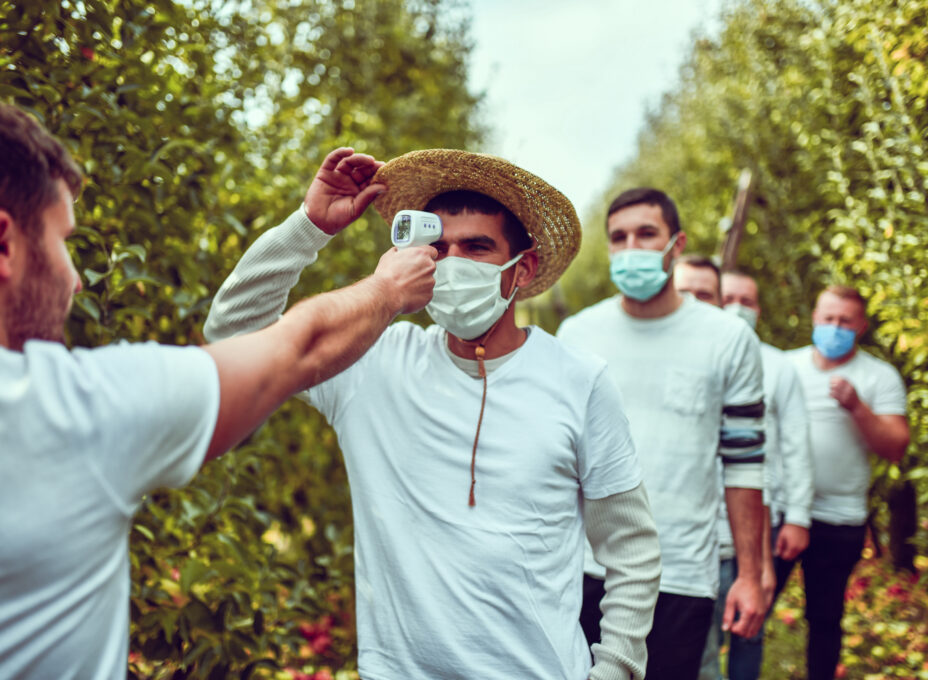It seems like every summer is accompanied by the hottest temperatures we’ve ever experienced.
But that isn’t just our personal opinion based on our most recent memory of extremely hot temperatures: According to the National Institutes of Health, climate change has caused a significant increase in temperatures globally; on average, temperatures have increased 1.1℃ every year since pre-industrial times.
All of our lives – in one way or another – have been affected by climate change and, in particular, rising temperatures.
But we’re not all affected equally – those who work outdoors, for example, bear the brunt of the current climate crisis.
For instance, on June 23rd, 2022, a 24-year-old construction worker by the name of Gabriel Infante died from severe heat stroke while working in intense heat in San Antonio, TX, succumbing to an internal temperature of 109.8℉ (43.2℃).
Like construction, agricultural work is strenuous and requires constant exertion, naturally raising the body’s internal temperature.
In addition to engaging in physically onerous work, farmworkers must also be weary of pesticides sprayed on harvest crops. Thus, their work attire is usually a long-sleeve shirt and jeans.
Although workers are somewhat protected from pesticide exposure by wearing clothing that covers most of their skin, it can, too, prevent their bodies from properly ventilating, increasing the chances of suffering a heat-related illness.
Efrain Lopez Garcia of Homestead, Florida, for instance, died when he was just 30-years-old while working in agriculture.
Mr. Lopez Garcia was not an inexperienced farmworker: He had toiled under extremely hot temperatures for eight summers, ultimately dying on July 6th, 2023, the hottest day recorded globally since 1979.
Stopping temperatures from rising is nearly an impossible feat, but there are ways we, as service providers, can help curb the frequency of heat-related illnesses and deaths among farmworkers.
Preventing Heat Stress-Related Illnesses:
Unfortunately, there are no federal laws or regulations mandating that employers provide agricultural workers breaks throughout the workday.
Moreover, in Texas, the legislature introduced House Bill 2127 (HB2127), which prohibits municipalities from enacting local ordinances that mandate breaks for workers engaged in outdoor work for long periods of time.
HB 2127, however, was blocked and dubbed unconstitutional by State District Judge Maya Guerra Gamble.
Laws and regulations intended to reduce the incidence of heat-related illnesses, if they exist, vary by jurisdiction.
It seems, then, that the best short-term strategy to prevent these occurrences is for workers to take personal measures to ensure they make it home to their families, and this starts by being aware of symptoms of heat stress – symptoms we could help workers become familiar with.
What Are the Symptoms of Heat Stress-Related Illnesses?
Illnesses induced by heat stress can range from something as minor as a heat rash, usually just a nuisance, to heat stroke, the most serious heat-related illness that could result in death.
Heat Rash:
A heat rash is a cluster of small blisters that can be observed throughout the body but usually around the neck, chest, and groin areas.
If a heat rash appears on a worker’s body, the worker should remove himself from direct sun exposure and stay in a cool, dry place. The worker can also apply baby powder to the affected areas to alleviate discomfort.
Sunburn:
Sunburn is caused by prolonged exposure to the sun. It usually manifests as red, warm – and sometimes painful – areas on our skin. Severe sunburn can even result in blisters.
To treat sunburn, workers should stay out of the sun until the affected areas are fully healed. This may not be viable for some workers employed in hand-harvested crops; nonetheless, they should cover the affected areas with cloths, such as clothing or bandannas.
Moisturizing lotions may help speed up the recovery process
Heat Cramps:
When workers experience heat cramps, usually identifiable by excessive sweating during exercise and muscle pain or spasms, they should stop any physical activity and move to a cool place, preferably indoors.
In addition to seeking refuge from the heat, workers should also drink lots of water or a hydrating sports drink to replace electrolytes and fluids lost through sweating.
If the cramps last more than one hour (or the worker is on a low-sodium diet or has a history of heart problems), however, the worker should get medical help as soon as possible.
Heat Exhaustion:
Heat exhaustion can be characterized by the following symptoms:
- Heavy sweating
- Cold, pale, and clammy skin
- Fast, weak pulse
- Nausea or vomiting
- Muscle cramps
- Tiredness or weakness
- Dizziness
- Headache
Workers must immediately address any of these symptoms by moving to a cool place and loosening layers of clothing. They should also put cool, wet cloths on their bodies or take a cool bath to bring down their internal temperatures.
Proper hydration is key to mitigating heat exhaustion. If the worker cannot hold down any fluids or exhibits worsening symptoms, they should seek medical attention right away.
Heat Stroke:
Heat stroke is the deadliest of heat-related illnesses. It is defined as a body temperature of 103℉ or higher. Other symptoms of heat stroke, according to the CDC, include hot, red, dry, or damp skin, fast or strong pulse, headache, dizziness, nausea, confusion, and loss of consciousness.
If a worker is experiencing symptoms of heat stroke, emergency responders should be contacted immediately.
While emergency responders arrive, the worker should be moved to a cool place and covered with damp cloths to lower their body temperature.
Unlike other heat-related illnesses that could be mitigated by proper hydration, the CDC recommends that people experiencing heat stroke not have anything to drink.
The Goal: To Prevent America’s Most Vulnerable Workers from Dying of Heat-Related Illnesses
As service providers, there are several ways we can help prevent farmworkers in Texas – and throughout the US – from dying of heat-related illnesses.
To prevent heat-related illnesses, we must first be aware of them and their respective symptoms.
Thus, education on heat stress is crucial: Workers can’t prevent something they aren’t even aware of.
We can educate workers on heat-related illnesses by hosting trainings or disseminating information on the same.
Likewise, we can also provide and encourage the use of items that can help prevent such illnesses, like caps, hats, bandannas, sweatshirts with hoodies, and light-colored clothing.
By becoming informed on and spreading knowledge of heat-related illnesses, we could potentially save lives and prevent some of America’s most vulnerable workers from dying while harvesting the foods that we comfortably consume daily.

